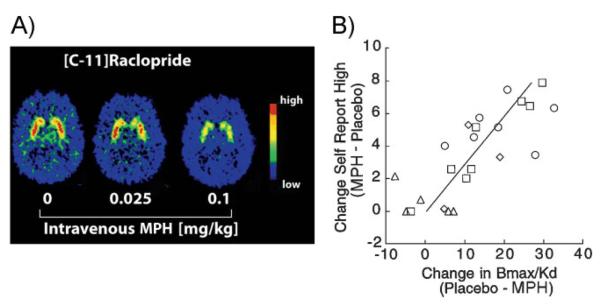Figure 1.
Stimulant-dependent DA increases in the striatum are associated with the feeling of “high.” A: Distribution volume (DV) images of [11C]raclopride for one of the subjects at baseline and after administration of 0.025 and 0.1 mg/kg i.v. of MPH. MPH-reduced binding of [11C]raclopride dose-dependently in the striatum, where it competes with DA for binding to DA D2 receptors (D2R). B: MPH significantly increased ratings of high. Regression lines for the correlation between MPH-induced changes in D2R availability in striatum and MPH-induced changes in self-reports of high (r 0.78, df22, p < 0.0001). PET studies are carried out with a radiolabeled compound such as [11C]raclopride that binds to dopamine receptors (D2R) whenever they are not occupied by DA. Measurements are done first after injection of a placebo and then, after drug administration, such that the difference in [11C]raclopride (positron) signal between the two conditions can be used to estimate the amount of receptor occupancy and, thus, the magnitude of any drug-induced DA increase. MPH was administered IV at the following doses (in mg/kg): 0.5 (circles), 0.25 (squares), 0.1 (diamonds), and 0.025 (triangles). Modified with permission from Volkow et al. [14].

